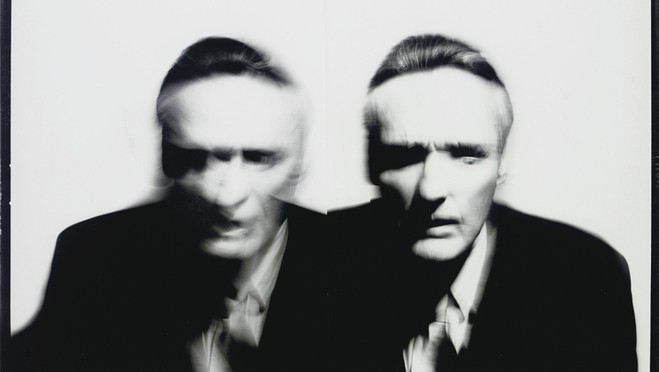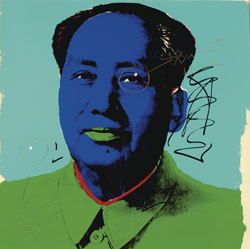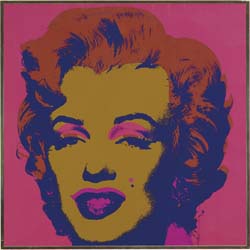
This image provided by Christies auction house in New York is a 1990 portrait of Dennis Hopper by photographer Victor Skrebenski. The photograph was sold by Hoppers estate during a two-day auction of his collection at Christies.
Dennis Hopper: Sold
It must have been fate. The single object that rose from the mix of hundreds of objects and pictures and posters from the property of Dennis Hopper was a 1972 blue Mao print by Andy Warhol that Hopper put two bullets through.
The prevailing legend is that Hopper woke up in the middle of the night and, in a fit of paranoia that seems lifted from a shooting script, he thought Mao, in blue, was in the room with him. As Hopper hallucinations might go, it doesnt sound terribly frightening, but Hopper grabbed a gun and shot twice at the picture. He hit both times, suggesting that he might not have been so groggy. It leaves you wondering what really happened.

Image: Andy Warhol (1928-1987) in collaboration with Dennis Hopper (1936-2010) Mao: one plate (F. & S. II. 99) screenprint in colors, 1972, on Beckett High White, signed in ball-point pen on the reverse, stamp-numbered 144/250 (there were also 50 artists proofs), co-published by Castelli Graphics and Multiples, Inc., New York, with the artists copyright stamp on the reverse, the full sheets.
When Hopper brought the damage to Warhols attention, the imperturbable Pop artist saw an opportunity. He drew on the print, calling one hole “a warning shot” and the other “bullet hole.” And the picture that was estimated to bring $20,000 to $30,000 at the sale of Hoppers property at Christies in New York sold for more than $300,000 to an Indian investment banker living in New York who usually collects antiquities. It was a record for a Mao print, and any Warhol record means money.
And if a kid born in Dodge City in 1936 cant have bullet holes as a signature, who can? Hoppers legend lives on.
The auction of hundreds of objects from Hoppers estate wasnt a feeding frenzy, although 856 lots that sold in the two days that included other objects besides those from Hoppers estate brought $3,427,413. The Hopper property totaled $1,955,758, nearly double the high estimate.
The event attracted dealers, collectors, fans and the odd figures who wandered in off the street with money to spend on art or ephemera, like the characters that Hopper played who emerged out of nowhere in the desert with a gleaming smile and a wild story.
Lets remember that the blue chip material from Hoppers collection was sold at Christies in November. Among the 30 works that brought a total of $12.8 million was an untitled work of mixed media from 1987 by Jean Michel Basquiat that sold for $5.8 million, plus paintings by Warhol and Keith Haring.
This week the works for sale with the highest profile after Warhol were by edgy imaginative California assemblage artists (Wallace Berman, Bruce Conner, George Herms). Hopper also collected people like Steve Calloway (whose portraits looked like the work of the Weimar artist Christian Schad) and the California painter of vibrant scenes with cars, John Valadez (one of whose paintings was bought by the Hammer Museum in Los Angeles). There were likenesses of Hopper, who looked surprisingly like Justin Timberlake when Roddy McDowell took his photograph in 1955. The mystique was alive already back then, at least among those who knew Hopper. Warhol would soon be one of them. Julian Schnabel drawings of Hopper were also on the block, as was the double exposure photo by Victor Skrebneski from 1990 that placed one Hopper image next to another in the fuzzy imprecision of Gerhard Richter. It sold for $9375.
And there were many many more, including the costume that Hopper wore in Waterworld (who remembered Hopper from this monumental flop?), complete with hat, eye-patch, underwear, and cape. It sold for $750 to a food mogul from Boston who had never been to an auction before and spent more than $20 thousand at the Hopper sale. Chris Tosi, the buyer from Boston, noted that, judging by the hat from the Waterworld suit, Hopper had a small head — which probably made him a more difficult target to hit with a bullet than Mao. Tosi has until next Halloween to make alterations on the hat, but he said the rest of the costume did fit ““ he admits that he didnt try on the underwear. Tosi was the only bidder on the suit. Like many other lots, the costume had no reserve ““ no minimum price set by the seller.
There was much talk in the press before the sale of Hopper as a collector, with the judgment that he had an eye for what was hip and new. A Christies specialist called it a “curatorial eye.” On examination, there was a dark edge to what he liked, but much of what he liked was made by people whom he knew. Hopper didnt need to be discerning. He was loyal, even to the aspiring collagist Vigo Mortensen. He bought work by his friends, or he bought the work that his friends recommended.
On January 10, the day before the sale, I walked into the Christies gallery where the auction was conducted. Posters for Hoppers films lined the walls. Works depicting

Andy Warhol (1928-1987) Marilyn: one plate (F. & S. II.27)screenprint in colors, 1967. Estimate: 40,000 - 60,000 U.S. dollars. Price Realized: $206,500.
prostitutes in a clownish pallor by the obscure Irish painter (transplanted to California) Patrick Morrison were alongside them. Another clown picture by Schnabels ex, Anh Duong, was on the back wall. (Hopper was indeed loyal to his friends, and the Anh Duong picture sold the next day.) On the floor was a pile of unframed pictures, stacked as if they were sheets of old veneer waiting to be mulched. You might not have been able to get one out the door, but you could have walked all over them.
The room had the feel of a house that was being dismantled, which is as good a description of the sale as any. Auctioneers, who switched after every fifty lots or so, were slowed down by the lag when Internet bids came in. One of them got impatient at the prospect of selling so much. But the bids from Europe kept coming in. It made sense. Along with Sean Penn and David Lynch, Hopper was Europes favorite American..
Spending two days watching Hoppers property move slowly off the block made you nostalgic for a time when artists supported each other. The sale didnt give you a picture of the man in full ““ it couldnt, as Hopper himself might have explained, since ex-wives got much of earlier “collections” when Hopper lacked the cash to meet divorce obligations, and was forced to sell.
I had a favorite lot, after the Waterworld costume, that is. It was a collection of three scripts from The Last Movie (1971), including a paper-bound script with an attached note from the producer Bert Schneider: “Dennis, found in an old file. Someday you may want to give it to some University.”
Someone had a different idea this time around. The scripts sold for about $8000. If a university had bought it, you would have read that in Christies press release.
(credit: All images courtesy of Christies.com)
